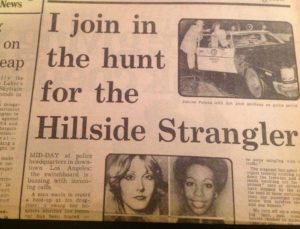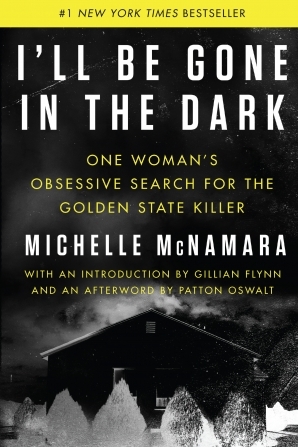 I have something in common with Michelle McNamara the author of the “astounding” true crime best seller, I’ll Be Gone In The Dark: We have both hunted serial killers who terrorized quiet neighborhoods, and brutally killed women in various parts of California four decades ago.
I have something in common with Michelle McNamara the author of the “astounding” true crime best seller, I’ll Be Gone In The Dark: We have both hunted serial killers who terrorized quiet neighborhoods, and brutally killed women in various parts of California four decades ago.
My “hunt” took place over the course of one night in 1978 when I joined a Los Angeles detective on patrol with the task force searching for the Hillside Strangler –a serial killer who claimed the lives of ten women in the Los Angeles area between 1977 and 1978. I was on assignment at the time for the London Evening News in which my article about the search (see photo) appeared.
Hunting Serial Killers
Michelle McNamara’s “hunt” occurred more recently, but also focussed on a serial predator who had committed at least 12 homicides and fifty rapes across five jurisdictions in California starting in 1976. However, that’s where any similarity between myself and Michelle ends. About a year after my night on patrol, and safely back in London, I learned that the Hillside Strangler was in fact two perpetrators, Kenneth Bianchi and Angelo Buono Jr., working together. They had both been apprehended, and would be subsequently tried, convicted and sentenced to life imprisonment.
She Never Knew
 Michelle, on the other hand, spent five years personally involved in the investigation into the identity of the monster she dubbed The Golden State Killer. She posted her first story about him on her website, True Crime Diary in 2011, and she was still researching and writing about him five years later. They were the last five years of her life — and she never learned the identity of the perpetrator because he was not apprehended until two years after she passed away in 2016, aged 46.
Michelle, on the other hand, spent five years personally involved in the investigation into the identity of the monster she dubbed The Golden State Killer. She posted her first story about him on her website, True Crime Diary in 2011, and she was still researching and writing about him five years later. They were the last five years of her life — and she never learned the identity of the perpetrator because he was not apprehended until two years after she passed away in 2016, aged 46.
At the time of her death, Michelle was working on her book about the investigation. Although she did not finish the manuscript, her husband, comedian Patton Oswalt turned over Michelle’s computer files and thousands of pages of notes to her research assistant, Paul Haynes and to Billy Jensen, an investigative journalist so they could complete her work. The book was posthumously published earlier this year. The non-fiction, true crime account, I’ll Be Gone In The Dark is subtitled: One Woman’s Obsessive Search for The Golden State Killer.
Astounding Story
 And, what a book it is! I simply could not put it down. It is totally the “astounding” story which bestselling Gone Girl author, Gillian Flynn introduces in a Foreword. And, it is so much more. It is a riveting tale told partly in chapters completed by Michelle, and partly in chapters compiled by Haynes and Jensen from her notes, her voluminous computer files and from a transcript of Michelle’s interview with Paul Holes, the equally obsessed investigator who on the eve of his retirement earlier this year finally nailed the alleged perpetrator.
And, what a book it is! I simply could not put it down. It is totally the “astounding” story which bestselling Gone Girl author, Gillian Flynn introduces in a Foreword. And, it is so much more. It is a riveting tale told partly in chapters completed by Michelle, and partly in chapters compiled by Haynes and Jensen from her notes, her voluminous computer files and from a transcript of Michelle’s interview with Paul Holes, the equally obsessed investigator who on the eve of his retirement earlier this year finally nailed the alleged perpetrator.
For one, it is not like any Ann Rule-type true crime book with which I became familiar years ago even though in Part One, McNamara seems to follow the conventions of true crime writing by detailing the crimes, the settings, and the stories of the victims. To be sure, it is a horrifying catalogue of rapes and killings by a perp who seemingly gained entry into the homes of his victims without much effort, and without any warning.
The rapist/killer is referred to through most of the book as EAR-ONS which stands for East Area Rapist-Original Night Stalker since he started his decade-long crime spree in 1976 by terrorizing the quiet, middle-class neighborhoods east of Sacramento. The monster gained entry into homes in the dead of night by slashing through screens, cutting through glass to reach interior handles and knobs, and lifting out sliding glass doors.
Of course, you remind yourself that all these crimes occurred a few decades before home security systems became the norm in private homes. Even so, it is almost impossible to read this first part of the book without looking over your shoulder at least once if you’re reading late at night, or in bed.
Online Sleuths
It is Part Two, however, that was the most eye-opening, riveting part of the book for me. It details Michelle’s own investigation into the killer she renamed the Golden State Killer(GSK) after DNA linked him to killings in Southern California as well as the rapes and burglaries he had committed in the Sacramento area. She writes about her interaction with true crime fans who these days are not just reading true crime stories, but are part of the story itself.
Variously described as online sleuths, Web detectives, or online obsessives this is how Michelle introduced them in her book:
” By the time DNA testing revealed crimes previously thought to be unrelated were the work of one man more than a decade had passed since his last known murder, and his capture wasn’t a priority […] The case dragged me under quickly […] I wasn’t alone. I found a group of hard-core seekers who congregated on an online message board and exchanged clues and theories[…] The sleuths have skills and they’re serious about using their skills to catch him.”
Her book is a fascinating insight into how that online sleuthing world operates, and how she became an expert in it, and it is such an engrossing aspect of her story I’ll be writing more about it next week. As the book subtitle suggests, her research became an obsession, and a 24/7 occupation. She combined her internet skills with a reporter’s ability to establish contacts among law enforcement types — especially retired detectives who were still haunted by this unsolved case. She turned to them for advice, bounced her theories off them, and accompanied them on tours of the areas where the crimes had occurred.
Killer’s DNA
Ultimately, however, she was obsessed with the idea that DNA was going to solve the identity of the Golden State Killer When Haynes and Jensen took over her notes and files they discovered that her “bucket list” included “figuring out a way to submit the killer’s DNA to the genealogy websites 23andme.com or Ancestry.com.” She had written that having GSK’s DNA was an ace up the investigation’s sleeve, “but the killer’s DNA is only as good as the database we can compare it to.”
Haynes and Jensen realized she wanted to be able to enter the killer’s DNA into the rapidly expanding commercial databases where a match could be returned with the last names of families with whom the killer might share a common ancestry– but neither 23andMe (with 1.5 million DNA profiles) nor Ancestry.com (with 2.5 million profiles) was willing to work with law enforcement because of privacy issues and their terms of service.
Distressing News
I was in the middle of reading Michelle’s book when the news of the Golden State Killer’s arrest made headlines across the country. This upset me more than initially finding out that Michelle McNamara had passed away before finishing her book. After all, what author doesn’t fear that an accident might befall him or her before he or she can finish that certain bestseller?
The idea that she would never know that the killer for whom she had searched all those years, and to whom she had devoted thousands of hours and pages had finally been found was even more distressing — until I got to the very end of the book.
Letter to An Old Man
 In her own words, Michelle McNamara wrote the following Epilogue: Letter To An Old Man speculating on why the GSK had stopped killing, and how she envisioned he would be found:
In her own words, Michelle McNamara wrote the following Epilogue: Letter To An Old Man speculating on why the GSK had stopped killing, and how she envisioned he would be found:
“I think you bailed when the world began to change […] You cut out when you looked over your shoulder and saw your opponents gaining on you […] An initial setback came in a lab when geneticist Alec Jeffreys developed the first DNA profile […] People who weren’t even aware of you or your crimes began devising algorithms that could help find you […] Smartphones. Customizable interactive maps. Familial DNA.
“Your heyday prowess has no value anymore. Your skill set has been phased out […] Virtual windows are opening all around you […] One day soon, you’ll hear a car pull up to your curb, an engine cut out. You’ll hear footsteps coming up your front walk […] The doorbell rings. No side gates are left open. You’re long past leaping over a fence […] This is how it ends for you.”

I felt better then because that’s exactly how it happened. Paul Holes, on the eve of his retirement, had entered the GSK’s DNA into a lesser known ancestry website ,and had come up with a list of people possibly related to GSK. After a process of elimination, he was left with a list that included the name of 72-year old James Joseph DeAngelo. Holes parked outside DeAngelo’s home for several days waiting for an opportunity to pick up items discarded by the suspect so that investigators could conclusively match the DNA. DeAngelo has now been charged in connection with eight homicides.
Next Week: The Fascinating World of Online Sleuths (where they meet, how they work) — and why author Michelle McNamara Was One of the Best
I must say Joanna, you have lived one interesting life 🙂
And, I’m not finished with it, yet, Eldon — although I may be slowing down a bit!!! Thanks for reading.